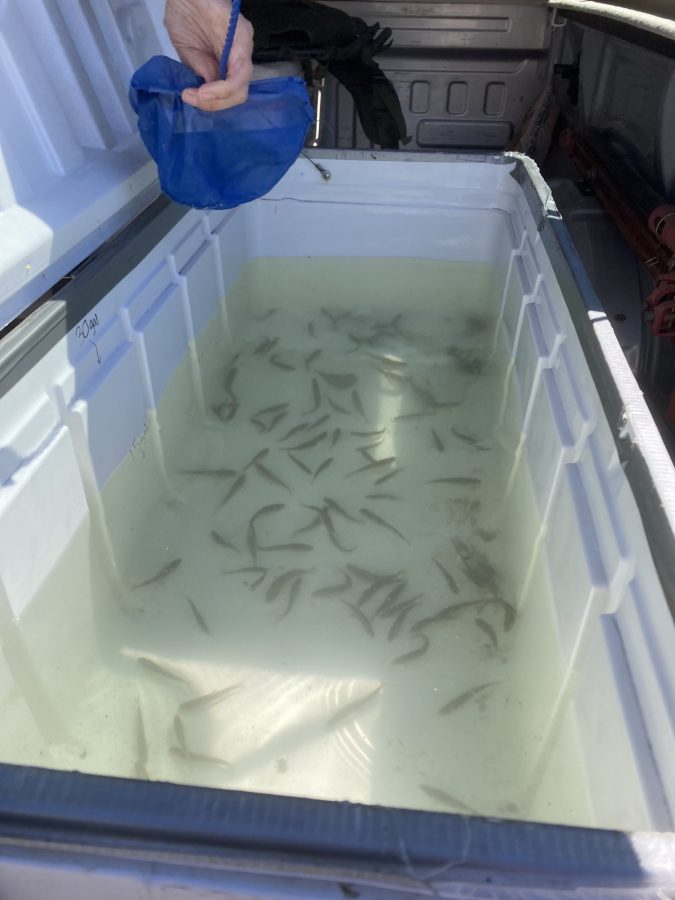Last month, the Santa Cruz River, which travels through the heart of Tucson, gained 600 new residents. Our newest neighbors are the longfin dace, a species of small fish that lived in the Santa Cruz River over 100 years ago before the river dried up due to overexploitation.
Thanks to Tucson Water’s Santa Cruz River Heritage Project, the portion of the river just south of downtown is now a striking riparian habitat. Natalie DeRoock, public information officer for the utility, explained that 1200 gallons of treated wastewater are pumped into the riverbed every minute. The project is an aquifer recharge project as the water sinks down through the soil to fill the aquifer. The project doubles as a habitat restoration project by recreating a riparian habitat that has long been absent from Tucson.
In October of 2020, the endangered Gila topminnow, a species of small native fish, was reintroduced to the Santa Cruz River Heritage Project, according to Betsy Grube, a topminnow and pupfish senior aquatic wildlife specialist from the Arizona Game and Fish Department. The reintroduction has been a success, prompting the question of which species should be reintroduced next. Longfin dace were historically residents of the Santa Cruz River, and today survive in what would be the river’s tributaries.
Grube explained that the agency had hoped that the dace would return to the Santa Cruz River on their own.
“Since they haven’t [returned], we wanted to help the process along, to make [the river] more of the native fishery that it could be,” Grube said.
RELATED: Water conservation and habitat restoration collide at the Santa Cruz River Heritage Project
The longfin dace is a particularly hardy species, making them a good candidate for reintroduction into a not-quite-natural river. According to Michael Bogan, an assistant professor in the University of Arizona’s School of Natural Resources and the Environment, dace have been known to survive out of water for a few hours.
“During a really hot day, [if a] stream dries up for a few hours that dace can actually survive in wet masses of algae without any standing water … then the temperatures go down, the groundwater can keep up with the evapotranspiration and then at night you go back [and] all the dace are swimming around again.”
Additionally, the longfin dace are protected under Pima County’s multispecies conservation plan, which covers 44 native species. Ian Murray, a program manager at Pima County’s Office of Sustainability and Conservation, explained that while Pima County aims to protect “the full spectrum of native plants and animals in Pima County … we want to ensure where we can, the persistence of those species in particular.”
Thus began the long process of reintroducing a fish. Grube explained the various steps of the process and the necessary considerations.
RELATED: The Health Science Center will expand new research opportunities to address addiction
Potential stocking populations, where fish would be taken from to move to the river, needed to be monitored. The right genetic lineage of fish to collect had to be decided on, and the Gila topminnow had to be considered. Permits for the collection and transportation of the fish had to be obtained. The reintroduction required the cooperation and collaboration of Tucson Water, the Arizona Game and Fish Department, the Sonoran Institute, Pima County and the U.S. Fish and Wildlife Service.
Bogan walked through what the reintroduction entailed. On the day of, a team set out to Vail and hiked to Cienega Creek, the chosen source for the dace to be transferred from. Using fine nets, 600 longfin dace were collected from the river and transferred to aerated buckets. The team then wore the buckets like backpacks and hiked out to the waiting transportation trucks. There, the fish were transferred to tanks and were driven to the release site at the Santa Cruz River Heritage Project and the Pima County release site, just downstream of their Agua Nueva Water Reclamation Facility.
At the river, care was taken to ensure the fish weren’t shocked by the water temperature in the river. Once ready, the fish were released into their new home. Bogan said of the reintroduction that “dace are pretty good at schooling, so it’s fun to see. We dump them out in small groups but then they find each other and make a school.”
RELATED: France-Arizona Institute for Global Grand Challenges panel discusses land conservation efforts
The reintroduction was a success, and the longfin dace will likely draw in more birds and other visitors — human and otherwise — in the future. Only one dace died in the reintroduction process.
While the longfin dace may not be endangered, Grube noted that the overutilization of water resources, climate change and continuing drought are a threat that has led to the extinction of many fish in Arizona. Murray explained that “the longfin dace is relatively common, it’s not protected, but we want to ensure that it remains common.” Projects like the longfin dace reintroduction ensure the future of the dace through proactive management.
Local residents are encouraged to visit the river and see the dace in person. While they’re small, their schools can be picked up by the presence of small black breeding males darting around. In a time when there’s a near-endless supply of bad environmental news, the Santa Cruz River Heritage Project is a great place to experience some good news in person.
Follow Hannah Johnson on Twitter









